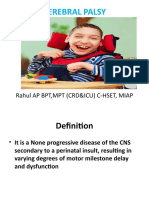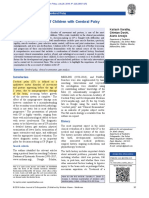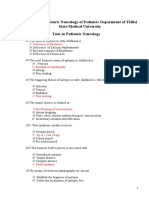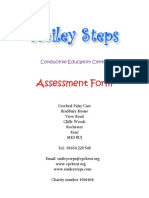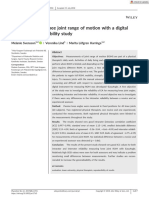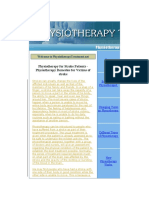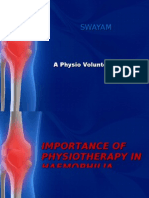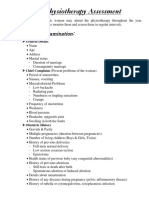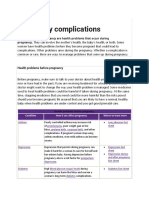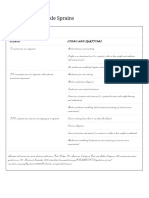Cerebral Palsy Assessment Form: History: Vision
Cerebral Palsy Assessment Form: History: Vision
Uploaded by
Rupam KanungoCopyright:
Available Formats
Cerebral Palsy Assessment Form: History: Vision
Cerebral Palsy Assessment Form: History: Vision
Uploaded by
Rupam KanungoOriginal Description:
Original Title
Copyright
Available Formats
Share this document
Did you find this document useful?
Is this content inappropriate?
Copyright:
Available Formats
Cerebral Palsy Assessment Form: History: Vision
Cerebral Palsy Assessment Form: History: Vision
Uploaded by
Rupam KanungoCopyright:
Available Formats
CEREBRAL PALSY ASSESSMENT FORM
Name: Date of Assessment:
Age:------- months/ years Address:
Gender:
Name of the Parent:
Source of information:
Parent Occupation:
Parent Education:
Primary Caregiver:
Parent/ care giver concern:
History: Vision
Hearing
Epilepsy – type, frequency, duration, under medication.
GMFCS Level:
CFCS Level:
MACS Level:
Developmental milestones:
Social/Emotional Language Cognitive(learning Hand function
communication thinking and problem Walks alone
Likes to hand Say several solving) Many walk up
things to others words Knows what steps and run
as play Says and ordinary things Pulls toys while
May have shakes head are for ex: walking
temper and ‘no’ telephone, Can help
tantrums Points to show brushes, spoon undress himself
May be afraid of some1 what he Points to one Drinks from a
strangers wants body part cup
Show affection Shows interest Eats with a
to familiar in a doll or spoon.
people stuffed animal
Play simple by pretending to
pretend, such feed
as feeding a Points to get the
doll attention of
May cling to others
caregivers in Scribbles on his
new situations own
Points to show Can follow 1
others step verbal
something commands with
JSS CPT, Department of Paediatric Physiotherapy Page 1 of 16
CEREBRAL PALSY ASSESSMENT FORM
interesting out any
Explores alone gestures for ex:
but with parent sits when you
close by say sit down
On Examination:
Deformity(If any)
All joint ROM
Limb Length Discrepancy: True limb length measurement:-
Apparent limb length measurement:-
Popliteal angle measurement:
Thomas test:
Dunken Ely’s test:
Silfverskiold test:
Tone assessment:
Tardieu scale
Energy expenditure Index
Resting Heart rate: _____beats/minute
Walking Heart rate: _____beats/minute
Distance covered: _____meters
Time: _____minutes
Speed: ______ meters/minute
JSS CPT, Department of Paediatric Physiotherapy Page 2 of 16
CEREBRAL PALSY ASSESSMENT FORM
ICF Format
Body structure Body Function
Activity Limitation
JSS CPT, Department of Paediatric Physiotherapy Page 3 of 16
CEREBRAL PALSY ASSESSMENT FORM
Participation restriction
Contextual factors
Environmental factors Personal factors
Facilitator Barrier Facilitator Barrier
JSS CPT, Department of Paediatric Physiotherapy Page 4 of 16
CEREBRAL PALSY ASSESSMENT FORM
ICF Domains and Core sets
ICF DOMAIN CORE SETS OUTCOME OUTCOME MEASURE
OF
INTEREST
Body Structure of upper Body Muscle Length
Structure and lower extremity alignment Spinal alignment and range of motion
measure (SAROMM)
Leg Length
Other
musculoskeletal
structures related to
movement
Structure of trunk
Exercise tolerance Energy Energy expenditure index
function efficiency
Function
Voluntary control Weakness Selective control assessment of the lower
and neuro- extremity (SCALE)
musculoskeletal, MMT
movement related Hand held dynamometry
function Functional strength grading
Gait pattern Gait Edinburgh visual gait score
functions performance
Activity Walking and Activity Gross motor function measure (GMFM)
mobility capacity and Functional mobility scale(FMS)
performance
Participation Going to school Participation Teacher and parent interview
and playing Functional mobility scale(FMS 150 m)
JSS CPT, Department of Paediatric Physiotherapy Page 5 of 16
CEREBRAL PALSY ASSESSMENT FORM
Spinal Alignment and Range of Motion Measure
(A Measure of Posture and Flexibility)
Spinal Alignment Subscale
1. Cervical Spine ____
2. Thoracic Spine ____
3. Lumbar Spine ____
4. Lateral Curve ____
Spinal Alignment Score ____
Mean score ____
Range of Motion and Muscle Extensibility Subscale
Right Left
5/6. Hip Extension ____ ____
7/8. Hip Flexion ____ ____
9/10. Hip Abduction ____ ____
11/12. Hip Adduction ____ ____
13/14. Hip ER ____ ____ Mean
15/16. Hip IR ____ ____ Hip score (add 5 to 16) ____ ……
17/18. Knee Extension ____ ____
19/20. Hamstrings ____ ____ Knee score (add 17 to 20) ____ …....
21/22. Ankle Dorsiflexion ____ ____
23/24. Ankle Plantarflexion ____ ____ Ankle score (add 21 to 24) ____ ……
25/26. Upper Extremities ____ ____ UE score (add 25 $ 26) ____ ……
Range of motion score _______
Total SAROMM Score_______
JSS CPT, Department of Paediatric Physiotherapy Page 6 of 16
CEREBRAL PALSY ASSESSMENT FORM
Hand Held Dynamometry
Muscle group Left Right
Lever Arm Torque (lbs) Lever Arm Torque (lbs)
Hip flexors
Hip extensors
Abductors
Adductors
Medial rotators
Lateral rotators
Knee flexors
Knee extensors
Ankle dorsiflexors
Ankle plantarflexors
Functional strength grading
Activity Ability Capacity Quality
Kneel sit to kneeling
Kneeling to half keeling
Sit to stand
Stand to sit
Up on toes
Heel down
Step up(20 cm step)
Step down
Lateral step up
Seated push up
Prone push up
Sit ups
JSS CPT, Department of Paediatric Physiotherapy Page 7 of 16
CEREBRAL PALSY ASSESSMENT FORM
Ability scoring
0- Unable
1- Completes with human assistance
2- Completes with walker/ 2 crutches/other device using both hands
3- Completes using a device with 1 hand
4- Independent. Requires supervision for safety
5- Independent and safe
If A is 2 or above 2 and capacity is 3 or more than rate quality under following phases
Preparation
Acceleration
Deceleration
Stabilization
Scoring:
1. Grossly altered
2. Display hesitancy/ occasionally/ mild compensation
3. Completes activity appropriately in Normal pattern
Thus score it as A: ,C: ,Q:
If C or Q is not relevant they will be marked as *
EVGS
LEFT RIGHT
Initial contact
Heel lift
Max ankle dorsi in stance
Hindfootvarus/valgus
Foot rotation
Clearance In swing
Max ankle dorsi in swing
Knee progression angle
Peak knee extn in stance
Knee extn in terminal swing
Peak knee flexion in swing
Peak hip extension in stance
JSS CPT, Department of Paediatric Physiotherapy Page 8 of 16
CEREBRAL PALSY ASSESSMENT FORM
Peak hip flexn in swing
Max pelvic obliquity in midstance
Pelvic rotation in midstance
Peak saggital trunk position
Max lateral shift of trunk
JSS CPT, Department of Paediatric Physiotherapy Page 9 of 16
CEREBRAL PALSY ASSESSMENT FORM
GMFM:
JSS CPT, Department of Paediatric Physiotherapy Page 10 of
16
CEREBRAL PALSY ASSESSMENT FORM
JSS CPT, Department of Paediatric Physiotherapy Page 11 of
16
CEREBRAL PALSY ASSESSMENT FORM
JSS CPT, Department of Paediatric Physiotherapy Page 12 of
16
CEREBRAL PALSY ASSESSMENT FORM
Dimension Percentage
A. lying and rolling
B. Sitting
C. Crawling and kneeling
JSS CPT, Department of Paediatric Physiotherapy Page 13 of
16
CEREBRAL PALSY ASSESSMENT FORM
D. Standing
E. Walking
FMS
Play assessment:
Play interest:
Length of play:
Investigations:
Provisional Diagnosis:
JSS CPT, Department of Paediatric Physiotherapy Page 14 of
16
CEREBRAL PALSY ASSESSMENT FORM
SMART Goals:
Short term goal:
Relevant to findings and should be based on ICF domain
Long term goal:
Parent /Care givers education.
Home programme.
Assessment Clinical reasoning
Name For Social interaction and identification
Age To rule out any delay in milestone
development
Source of information To get the correct history
Limb length discrepancy To rule out shortening and to prescribe foot
wear.
Popliteal angle To assess hamstring
Dunken Ely’s test To assess rectus femoris spasticity or tightness
Thomas test To assess Ilioposas
Silfverskiold To determine the isolation of gastrocnimeus
and soleus function
Tardieu Scale To rule out static or dynamic tightness.
To refer for botox or tendon release.
GMFCS To know the current motor function.
Emphasis is on usual performance in home,
school and community settings (what they do)
rather than what they are known to be able to
do at their best (capability). It is therefore
important to classify current performance in
gross motor function.
CFCS To rule out communication disorders.
Tells how the information is expressed and
received.
MACS To classify how the children use their hands
while handling objects in daily activities(i.e)
quantity and quality of performance and need
JSS CPT, Department of Paediatric Physiotherapy Page 15 of
16
CEREBRAL PALSY ASSESSMENT FORM
for assistance or adaptations to perform
manual tasks in daily activity.
EEI To determine energy requirements to rule out
their physical activity level.
GMFM To detect and tell about the transition changes
in gross motor function in children with CP
SAROM Spinal mal alignment and limited ROM are
correlated with decline in gross motor function
SAROM tells about the spinal alignment in CP
children for cervical,thoracic and lumbar region
and describe the pattern of restrictions in these
areas.
JSS CPT, Department of Paediatric Physiotherapy Page 16 of
16
You might also like
- StrokeDocument6 pagesStrokeRaulLopezJaime67% (3)
- Cerebral Palsy AssessmentDocument6 pagesCerebral Palsy AssessmentdrprasantNo ratings yet
- Fall Risk Assess OsceDocument2 pagesFall Risk Assess OsceLamyaa Ali Hasan100% (1)
- Ultramodern 5 - Ficha EditávelDocument1 pageUltramodern 5 - Ficha EditávelSilvio Marcelino de OliveiraNo ratings yet
- Physio Neuro Ax TemplateDocument8 pagesPhysio Neuro Ax TemplateHussain LaftaNo ratings yet
- Cardiorespiratory Case Presentation Sem 8Document29 pagesCardiorespiratory Case Presentation Sem 8Mika Araxia100% (1)
- DMD IE PediaDocument9 pagesDMD IE Pediamagee syNo ratings yet
- Systems Review MnemonicsDocument4 pagesSystems Review MnemonicsNatasha JuchkovNo ratings yet
- Falls in ElderlyDocument21 pagesFalls in ElderlyJim Christian EllaserNo ratings yet
- William W. Hallo - The World's Oldest Literature - Studies in Sumerian Belles-Lettres (2009) PDFDocument801 pagesWilliam W. Hallo - The World's Oldest Literature - Studies in Sumerian Belles-Lettres (2009) PDFSrood Talib100% (5)
- Section 6 QuizDocument33 pagesSection 6 QuizImas Rohayati100% (2)
- Cerebral Palsy: Rahul Ap BPT, MPT (Crd&Icu) C-Hset, MiapDocument44 pagesCerebral Palsy: Rahul Ap BPT, MPT (Crd&Icu) C-Hset, MiapAbijah susanNo ratings yet
- W1-1 Growth and Development I - LectureDocument96 pagesW1-1 Growth and Development I - Lectureali fawziNo ratings yet
- Neuro AssessmentDocument6 pagesNeuro AssessmentKabilan RNo ratings yet
- Clinical Examination of Children With Cerebral PalsyDocument10 pagesClinical Examination of Children With Cerebral PalsyYogin PatelNo ratings yet
- Tests in Pediatric NeurologyDocument23 pagesTests in Pediatric NeurologyWartuhi GrigoryanNo ratings yet
- GONIOMETRYDocument28 pagesGONIOMETRYnn2dgdypkcNo ratings yet
- Paediatric Physiotherapy Involves The AssessmentDocument2 pagesPaediatric Physiotherapy Involves The AssessmentL RNo ratings yet
- Back Pain History TakingDocument4 pagesBack Pain History TakingAmjad_2020No ratings yet
- Physical Therapy Patient Assessment FormDocument7 pagesPhysical Therapy Patient Assessment FormZA IDNo ratings yet
- B P O M: Rachial Lexus Utcome EasureDocument14 pagesB P O M: Rachial Lexus Utcome EasureVirginia Feren FraganzhaNo ratings yet
- Cerebral PalsyDocument44 pagesCerebral PalsyprinceejNo ratings yet
- Brown Séquard SyndromeDocument4 pagesBrown Séquard SyndromeDKANo ratings yet
- Distal Femur FracturesDocument42 pagesDistal Femur FracturesSamujjwal SwapnilNo ratings yet
- Navicular Drop Test ProtocolDocument8 pagesNavicular Drop Test ProtocolNiken Dwi SaraswatiNo ratings yet
- Physiotherapy Assessment and Treatment On PICUDocument54 pagesPhysiotherapy Assessment and Treatment On PICUBatool Rehman100% (3)
- Six Minute Walk Test (6MWT) Recording FormDocument2 pagesSix Minute Walk Test (6MWT) Recording FormElan R.S.No ratings yet
- Coordination Exercise 3Document16 pagesCoordination Exercise 3Ella CooperNo ratings yet
- Assessment Form CPDocument13 pagesAssessment Form CPvmsvino100% (2)
- Measurement of Knee Joint Range of Motion With A Digital Goniometer: A Reliability StudyDocument7 pagesMeasurement of Knee Joint Range of Motion With A Digital Goniometer: A Reliability StudyTripatdeep SinghNo ratings yet
- Cardiorespiratory AssessmentDocument7 pagesCardiorespiratory AssessmentmalarvelykNo ratings yet
- 8758 - PPT AchondroplasiaDocument33 pages8758 - PPT AchondroplasiaFidesha Nurganiah SiregarNo ratings yet
- DM CaseDocument11 pagesDM CasesainaNo ratings yet
- MCQ PartDocument6 pagesMCQ PartUsama El BazNo ratings yet
- Neurological Assessment: Alice E. Davis, PH.D., RNDocument6 pagesNeurological Assessment: Alice E. Davis, PH.D., RNdhekuh100% (2)
- Lumbar Disc HerniationDocument29 pagesLumbar Disc HerniationFAISAL AHMAD YUSUFNo ratings yet
- Apgar ScoringDocument7 pagesApgar ScoringJessica Alvarado Jermias100% (1)
- Physical Agent ModalitiesDocument13 pagesPhysical Agent ModalitiesLeonardo MustopoNo ratings yet
- Discuss Surgical Management of Cerebral Palsy - 000Document72 pagesDiscuss Surgical Management of Cerebral Palsy - 000SamNo ratings yet
- Growth and Development Concept and Characteristics Factors Affecting Growth and DevelopmentDocument20 pagesGrowth and Development Concept and Characteristics Factors Affecting Growth and Developmentmuhammad usman munawarNo ratings yet
- Juvenile Rheumatoid Arthritis: Dorothy W. Wortmann, MDDocument38 pagesJuvenile Rheumatoid Arthritis: Dorothy W. Wortmann, MDLavi GoyalNo ratings yet
- Sensory Examination For Physiotherapy Student - NeuroDocument25 pagesSensory Examination For Physiotherapy Student - NeuroAnand VaghasiyaNo ratings yet
- Health and Wellness: DR Kainat Faizan BSPT (G Old-Medalist), PPDPTDocument32 pagesHealth and Wellness: DR Kainat Faizan BSPT (G Old-Medalist), PPDPTAflaha KhanNo ratings yet
- Sci Asia Scale PPT (Final)Document29 pagesSci Asia Scale PPT (Final)palNo ratings yet
- CRANIOVETEBRALJUNCTIONDocument130 pagesCRANIOVETEBRALJUNCTIONdrarunrao100% (1)
- All Orthopedic TestsDocument7 pagesAll Orthopedic Testschandran2679No ratings yet
- Physiotherapy For Stroke Patients - Physiotherapy Remedies For Victims of StrokeDocument9 pagesPhysiotherapy For Stroke Patients - Physiotherapy Remedies For Victims of StrokeHumaira RahmanNo ratings yet
- Contrast Bath PDFDocument7 pagesContrast Bath PDFAZOZ 19No ratings yet
- HEMEPARESISDocument18 pagesHEMEPARESISHari EshwaranNo ratings yet
- Shoulderexaminationppt 180505152418Document19 pagesShoulderexaminationppt 180505152418KarthickNo ratings yet
- GaitDocument42 pagesGaitTan Geok EngNo ratings yet
- Modified Ashworth ScaleDocument3 pagesModified Ashworth ScaleSundarajan ManiNo ratings yet
- Examination of CoordinationDocument17 pagesExamination of CoordinationSalman KhanNo ratings yet
- Cerebral Palsy AssessmentDocument8 pagesCerebral Palsy Assessmentrajalaxmi gopalakrishnanNo ratings yet
- General Neurological Assessment: Shemjaz Arakkal MDocument54 pagesGeneral Neurological Assessment: Shemjaz Arakkal MRaghu NadhNo ratings yet
- Importance of Physiotherapy in HaemophiliaDocument48 pagesImportance of Physiotherapy in HaemophiliaPhysioVolunteers100% (3)
- Range of Muscle Work.Document54 pagesRange of Muscle Work.Salman KhanNo ratings yet
- Obstretics AssessmentDocument6 pagesObstretics AssessmentToli kkakrNo ratings yet
- Ventricular Septal Defect, A Simple Guide To The Condition, Treatment And Related ConditionsFrom EverandVentricular Septal Defect, A Simple Guide To The Condition, Treatment And Related ConditionsNo ratings yet
- Cerebral Palsy Assessment Form: History: VisionDocument16 pagesCerebral Palsy Assessment Form: History: VisionRupam KanungoNo ratings yet
- Clinical Passport 2nd Placement 1Document6 pagesClinical Passport 2nd Placement 1api-584598939No ratings yet
- Rehabilitation Approach of Children With Cerebral PalsyDocument55 pagesRehabilitation Approach of Children With Cerebral PalsyridaNo ratings yet
- Llorens Facilitation and Growth DevelopmentDocument20 pagesLlorens Facilitation and Growth DevelopmentAarthi ArumugamNo ratings yet
- Principles of Geriatric Physiotherapy-CDDocument194 pagesPrinciples of Geriatric Physiotherapy-CDFerdinan Fangestu100% (2)
- Complications of PregnancyDocument10 pagesComplications of PregnancyRupam KanungoNo ratings yet
- Cerebral Palsy Assessment Form: History: VisionDocument16 pagesCerebral Palsy Assessment Form: History: VisionRupam KanungoNo ratings yet
- Grades of Ankle SprainDocument2 pagesGrades of Ankle SprainRupam KanungoNo ratings yet
- Principles of Exercise Fitness and Health Mock Exam Questions Flashcards PreviewDocument21 pagesPrinciples of Exercise Fitness and Health Mock Exam Questions Flashcards PreviewRupam Kanungo100% (1)
- DLA-Vessels Guide E-Feb14 PDFDocument68 pagesDLA-Vessels Guide E-Feb14 PDFAnonymous xPBUKuVsj4No ratings yet
- How To Spend It: Obama Warns of Lengthy F Iscal CrisisDocument56 pagesHow To Spend It: Obama Warns of Lengthy F Iscal CrisisHassan GardeziNo ratings yet
- GUIDELINES FOR PREPARATION OF OIL SPILL RESPONSE CONTINGENCY PLAN OISD - GUIDELINES-200 Amended Edition October 2002 - OISD-GDN-200Document36 pagesGUIDELINES FOR PREPARATION OF OIL SPILL RESPONSE CONTINGENCY PLAN OISD - GUIDELINES-200 Amended Edition October 2002 - OISD-GDN-200Vaishnavi JayakumarNo ratings yet
- Psyease 4TH Sem Physiology Module-2Document6 pagesPsyease 4TH Sem Physiology Module-2Rasna PNo ratings yet
- Doga TestersDocument12 pagesDoga TestersihtishamuddNo ratings yet
- CR 92-Lesson 3 Legal Forms Sworn Statement-DeclarationDocument6 pagesCR 92-Lesson 3 Legal Forms Sworn Statement-DeclarationJoebell VillanuevaNo ratings yet
- Chapter 3 LokaDocument29 pagesChapter 3 Lokaempty2418No ratings yet
- Lyrics For Bale by Niniola FeatDocument4 pagesLyrics For Bale by Niniola FeatBabajide AdedapoNo ratings yet
- NX3669Document4 pagesNX36692592323367No ratings yet
- De Thi Khao Sat HSG 12 Mon Tieng AnhDocument8 pagesDe Thi Khao Sat HSG 12 Mon Tieng AnhbuitinhNo ratings yet
- Contracts: ContractDocument11 pagesContracts: ContractAlmineNo ratings yet
- Atestat Morarescu Andrei - Techno MusicDocument40 pagesAtestat Morarescu Andrei - Techno MusicAndrei MorarescuNo ratings yet
- Department of Business Administration: Rani Channamma UniversityDocument96 pagesDepartment of Business Administration: Rani Channamma Universitysriram tarunNo ratings yet
- Eco Ges L1 s1 WK 1 Assessment + CurriculumDocument7 pagesEco Ges L1 s1 WK 1 Assessment + CurriculumSamir MokraniNo ratings yet
- Smart Blind Stick PDFDocument63 pagesSmart Blind Stick PDFSandeep38% (8)
- ECA2+ Tests Language Test 7B 2018Document5 pagesECA2+ Tests Language Test 7B 2018Cubi ArtNo ratings yet
- Replacement and Retention Decisions: Gra W HillDocument101 pagesReplacement and Retention Decisions: Gra W HillalfaselNo ratings yet
- Ux Foundation Specimen PaperDocument13 pagesUx Foundation Specimen PaperalissmayoloweNo ratings yet
- Ochoa vs. Apeta G.R. No. 146259Document3 pagesOchoa vs. Apeta G.R. No. 146259Hannah Keziah Dela CernaNo ratings yet
- Books Dictionaries 1Document4 pagesBooks Dictionaries 1socratesNo ratings yet
- Ebsd (Electron Backscattered Diffraction)Document45 pagesEbsd (Electron Backscattered Diffraction)mm11_nedNo ratings yet
- Eapp Q4 W1 Las3Document2 pagesEapp Q4 W1 Las3che segNo ratings yet
- PMP Math Prep Final Quiz Time Cost 1Document12 pagesPMP Math Prep Final Quiz Time Cost 1Mohamed Arbi Ben YounesNo ratings yet
- Numerical MethodsDocument146 pagesNumerical MethodswecharriNo ratings yet
- ACD Guidelines PDFDocument11 pagesACD Guidelines PDFAci LusianaNo ratings yet
- STD 8 - 2nd Revision Test - XLSX - VIIIDocument6 pagesSTD 8 - 2nd Revision Test - XLSX - VIIIRetika RajputNo ratings yet
- Book - Mid DelectablesDocument166 pagesBook - Mid Delectablesmdbilal2812001No ratings yet











